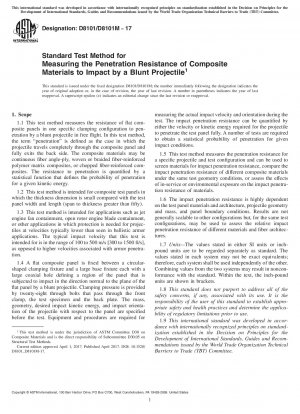ASTM D8101/D8101M-17
Standard Test Method for Measuring the Penetration Resistance of Composite Materials to Impact by a Blunt Projectile
- Standard No.
- ASTM D8101/D8101M-17
- Release Date
- 2017
- Published By
- American Society for Testing and Materials (ASTM)
- Status
- Replace By
- ASTM D8101/D8101M-18
- Latest
- ASTM D8101/D8101M-18
- Scope
-
5.1 Advanced composite systems are used in a number of applications as shields to prevent penetration by projectiles. In general, the use of composites is more effective for blunt, rather than sharp, projectiles or in hybrid systems in which an additional shield can be used to blunt a sharp projectile. Knowledge of the penetration impact resistance of different material systems or the effects of environmental or in-service load exposure to the penetration resistance of given materials is useful for product development and material selection.
5.2 An impact test used to measure the penetration resistance of a material can serve the following purposes:
5.2.1 To quantify the effect of fiber architecture, stacking sequence, fiber and matrix material selection, and processing parameters on the penetration resistance of different composite materials;
5.2.2 To measure the effects of environmental or in-service load exposure on the penetration impact resistance of a given material system; and
5.2.3 As a tool for quality assurance requirements for materials designed for penetration resistance applications.
5.3 The penetration resistance values obtained with this test method are most commonly used in material specification and selection and research and development activities. The data are not intended for use in establishing design allowables, as the results are specific to the geometry and physical conditions tested and are not generally scalable to other configurations.
5.4 The reporting section requires items that tend to influence the penetration resistance of material systems. These include the following: fiber and matrix materials, fiber architecture, layup sequence, methods of material fabrication, environmental exposure parameters, specimen geometry and overall thickness, void content, specimen conditioning, testing environment and exposure time, specimen fixture and alignment, projectile mass and geometry, and projectile orientation at impact. Additional reporting requirements include size and description of damage, results of any pre- and post-test nondestructive inspection, impact velocity, accuracy of the velocity measurement apparatus, and whether or not the projectile penetrated the panel. Residual velocity is a desirable, but not a necessary, value to be reported.
5.5 The reporting section shall also include the parameters of a statistical function that gives the probability of penetration as a function of impact kinetic energy (see 14.4).
5.6 The relevant measurements that result from the impact test are the kinetic energy and impact velocity of the projectile and whether or not the projectile penetrated the specimen. An optional item to be measured is the loss in kinetic energy of the projectile as a function of impact velocity if measurements of the residual velocity are recorded.
1.1 This test method measures the resistance of flat composite panels in one specific clamping config......
ASTM D8101/D8101M-17 Referenced Document
- ASTM A36/A36M Standard Specification for Carbon Structural Steel
- ASTM D3171 Standard Test Methods for Constituent Content of Composite Materials
- ASTM D3878 Standard Terminology Composite Materials
- ASTM D5229/D5229M Standard Test Method for Moisture Absorption Properties and Equilibrium Conditioning of Polymer Matrix Composite Materials
- ASTM D5687/D5687M Standard Guide for Preparation of Flat Composite Panels with Processing Guidelines for Specimen Preparation
- ASTM D792 Standard Test Methods for Density and Specific Gravity (Relative Density) of Plastics by Displacement
- ASTM D883 Standard Terminology Relating to Plastics
- ASTM E2533 Standard Guide for Nondestructive Examination of Polymer Matrix Composites Used in Aerospace Applications
ASTM D8101/D8101M-17 history
- 2018 ASTM D8101/D8101M-18 Standard Test Method for Measuring the Penetration Resistance of Composite Materials to Impact by a Blunt Projectile
- 2017 ASTM D8101/D8101M-17 Standard Test Method for Measuring the Penetration Resistance of Composite Materials to Impact by a Blunt Projectile

Copyright ©2024 All Rights Reserved